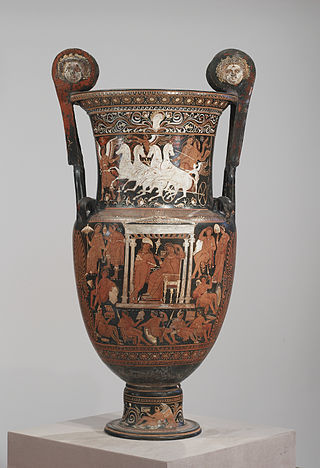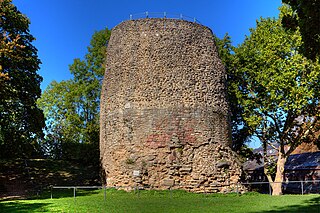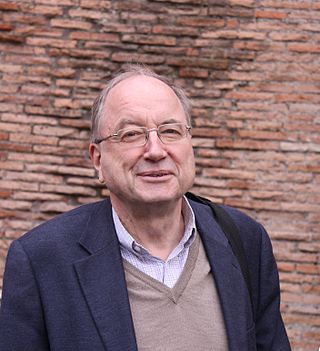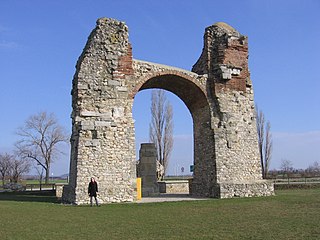
Marcus Junkelmann (born 2 October 1949 in Munich) is a German historian and experimental archeologist.

Marcus Junkelmann (born 2 October 1949 in Munich) is a German historian and experimental archeologist.
Junkelmann was born in Munich to the art historian Erich Junkelmann and his wife Charlotte. The family soon moved to Schleißheim and took residence in the Lustheim_Palace, where Junkelmann spent his youth. He graduated 1969 from the Dom-Gymnasium Freising (high school) and started to study history at Ludwig Maximilian University of Munich in 1971. In 1979 he received his PhD for a thesis on the military achievements of Maximilian II (1662–1726) (original title: Kurfürst Max Emanuel von Bayern als Feldherr). After that he worked as an associate member of staff at the university and for the Bayerisches Armeemuseum (military museum) in Ingolstadt.
In the 1980s Junkelmann became well known in Germany for his work in experimental archeology. He reconstructed and tested Roman weapons and army gear. In 1985 in connection with the 2000 year celebration of the city of Augsburg he organized a large experimental reenactment of the life and work conditions of Roman legionaries. The experiment consisted of a month-long march from Verona to Augsburg including a crossing of the Alps. For the complete trip the original Roman army gear and equipment was used and the typical legionary tasks were performed. Later Junkelmann went on to perform a similar experiments for the Roman cavalry. He authored several books and documentaries on his archeological experiments. In 1997 he was awarded the Ceram Prize for his book on the nutrition of Roman soldiers (original title: Panis militaris: Die Ernährung des römischen Soldaten oder der Grundstoff der Macht).
In 2012 Junkelmann was awarded the Bavarian Order of Merit.
Gerhard M. Koeppel was a German-born historian of Roman art and a specialist in the study of Roman historical relief sculpture. Koeppel studied at the University of Cologne and under the ancient art historian Heinz Kähler. Gerhard Koeppel was a member of the Archaeological Institute of America, the Classical Society of the American Academy in Rome, the Deutscher Archäologenverband, and Corresponding Member of the Deutsches Archaeologisches Institut. He was Resident Scholar at the American Academy in Rome (1974–1975), Professor-in-Charge of the Intercollegiate Center for Classical Studies in Rome, and Director of the American Academy Summer School (1986–1988). He joined the faculty of Classics at the University of North Carolina at Chapel Hill in 1969 and was professor emeritus at the time of his death.

The Eretria Painter was an ancient Greek Attic red-figure vase painter. He worked in the final quarter of the 5th century BC. The Eretria Painter is assumed to have been a contemporary of the Shuvalov Painter; he is considered one of the most interesting painters of his time. Many of his best works are painted on oinochoai and belly lekythoi. His paintings often depict many figures, moving in groups across all available surfaces. He also painted such vessels as figure-shaped vases or head-shaped kantharoi. Even as the vase shapes he painted on are unusual, his themes are conventional: athletes, satyrs and maenads, and mythological scenes. There are also some careful studies of women. He also painted white-ground vases. A lekythos in New York shows a funeral scene, typical of white-ground painting: Achilles is mourning Patroclus; the nereids bring him new weapons. The Eretria Painter's drawing style influenced later artists, e.g. the Meidias Painter and his school.

The Baltimore Painter was an Apulian vase painter whose works date to the final quarter of the 4th century BC. He is considered the most important Late Apulian vase painter, and the last Apulian painter of importance. His conventional name is derived from a vase kept at the Walters Art Museum in Baltimore.

The Battle of Lake Constance was a small naval battle between Roman forces and Celtic tribes in the spring of 15 BC.
The Ceram Prize is a prize for non-fiction books in archaeology issued by Rheinisches Landesmuseum Bonn. It is named for C. W. Ceram, famous for his popularization of archaeology.

The Drususstein is a nearly 20 metres high masonry block of Roman origin on the grounds of the citadel of Mainz, Germany. It was originally cased in marble. Researchers now largely accept that this is the structural remnant of the cenotaph mentioned by writers such as Eutropius and Suetonius, erected in 9 BC by Roman troops in honour of the deceased general Drusus, in Mogontiacum.
Paul Zanker is the professor of Storia dell’Arte Antica at the Scuola Normale Superiore in Pisa. Previously Zanker was professor of classical archaeology at the University of Munich (1976–2002) and the University of Göttingen (1972–1976). He is a noted expert on Roman art and archaeology and a member of the Bavarian Academy of Sciences, corresponding Fellow of the British Academy, of the Academia Europaea, of the Royal Danish Academy of Sciences and Letters, the Pontifical Academy of Archaeology and of the German Archaeological Institute. From 1990 to 1991 he was the Sather professor of the University of California at Berkeley. Zanker is head of the German Commission for the Corpus Vasorum Antiquorum.

The Upper Germanic-Rhaetian Limes, or ORL, is a 550-kilometre-long section of the former external frontier of the Roman Empire between the rivers Rhine and Danube. It runs from Rheinbrohl to Eining on the Danube. The Upper Germanic-Rhaetian Limes is an archaeological site and, since 2005, a UNESCO World Heritage Site. Together with the Lower Germanic Limes it forms part of the Limes Germanicus.
Matthias Steinhart is a German Classical archaeologist.
Michael Siebler is a German journalist and classical archaeologist.

Heidemarie Koch was a German Iranologist.

Henner von Hesberg is a German classical archaeologist.

Hermann Parzinger is a German historian who is a specialist in the culture of the Scythians. He has been president of the Prussian Cultural Heritage Foundation since 1 March 2008 and the Executive President of Europa Nostra since 2018.

The Lower Germanic Limes is the former frontier between the Roman province of Germania Inferior and Germania Magna. The Lower Germanic Limes separated that part of the Rhineland left of the Rhine as well as the southern part of the Netherlands, which was part of the Roman Empire, from the less tightly controlled regions east of the Rhine.

The Neckar-Odenwald Limes is a collective term for two, very different early sections of the Upper Germanic-Rhaetian Limes, a Roman defensive frontier line that may have been utilised during slightly different periods in history. The Neckar-Odenwald Limes consists of the northern Odenwald Limes (Odenwaldlimes), a cross-country limes with camps, watchtowers and palisades, which linked the River Main with the Neckar, and the adjoining southern Neckar Limes (Neckarlimes), which in earlier research was seen as a typical 'riverine limes', whereby the river replaced the function of the palisade as an approach obstacle. More recent research has thrown a different light on this way of viewing things that means may have to be relativized in future. The resulting research is ongoing.

The Pannonian Limes is part of the old Roman fortified frontier known as the Danubian Limes that runs for approximately 420 km (260 mi) from the Roman camp of Klosterneuburg in the Vienna Basin in Austria to the castrum in Singidunum (Belgrade) in present-day Serbia. The garrisons of these camps protected the Pannonian provinces against attacks from the north from the time of Augustus (31 BC–14 AD) to the beginning of the 5th century. In places this section of the Roman limes also crossed the river into the territory of the barbarians (Barbaricum).
Volkert Haas was a German Assyrologist and Hittitologist.

The Roman villa of Rabaçal in Rabaçal near Penela was located near the Roman road from Olisipo to Bracara Augusta (Braga) in Portugal. The excavations begun in 1984 exposed the layout of a villa, the center of which is an octagonal peristyle around which the other rooms are grouped symmetrically. The pars rustica was located in the north, the pars urbana in the western areas. The mosaics which are covered today for protection form a separate group. They are figurative :the seasons, quadriga, a seated female figure and some of the geometrical and vegetal compositions differ from any others existing in Portugal.
Maria Radnoti-Alföldi was a Hungarian-German archaeologist and numismatist specialising in the Roman period. She is known for her research into the analysis of the distribution of coin finds, Roman history, and the self-depiction of the Roman emperors.